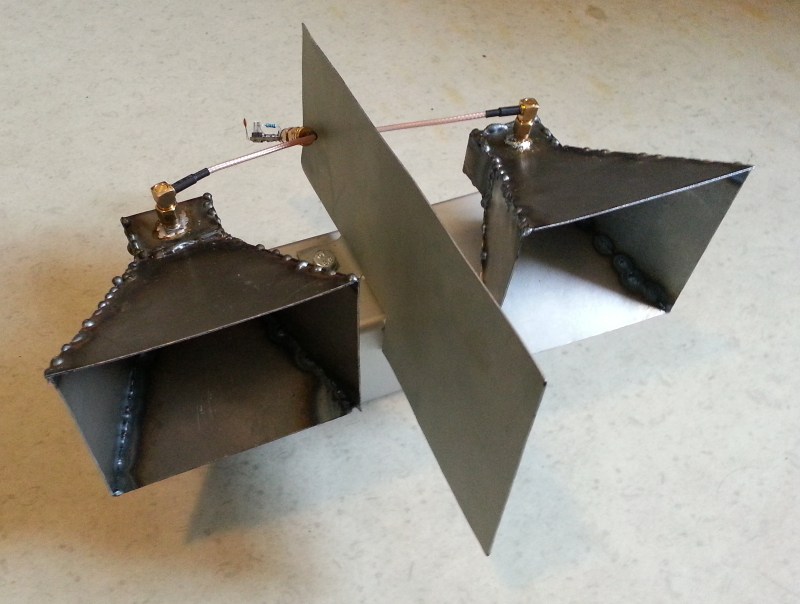So you’ve built yourself an awesome radar system but it’s not performing as well as you had hoped. You assume this may have something to do with the tin cans you are using for antennas. The obvious next step is to design and build a horn antenna spec’d to work for your radar system. [Henrik] did exactly this as a way to improve upon his frequency modulated continuous wave radar system.
To start out, [Henrik] designed the antenna using CST software, an electromagnetic simulation program intended for this type of work. His final design consists of a horn shape with a 100mm x 85mm aperture and a length of 90mm. The software simulation showed an expected gain of 14.4dB and a beam width of 35 degrees. His old cantennas only had about 6dB with a width of around 100 degrees.
The two-dimensional components of the antenna were all cut from sheet metal. These pieces were then welded together. [Henrik] admits that his precision may be off by as much as 2mm in some cases, which will affect the performance of the antenna. A sheet of metal was also placed between the two horns in order to reduce coupling between the antennas.
[Henrik] tested his new antenna in a local football field. He found that his real life antenna did not perform quite as well as the simulation. He was able to achieve about 10dB gain with a field width of 44 degrees. It’s still a vast improvement over the cantenna design.
If you haven’t given Radar a whirl yet, check out [Greg Charvat’s] words of encouragement and then dive right in!

















those welds are atrocious
Everyone starts some where and they did exactly what they needed to do.
For all you know he could be using a 220 volt mig with .035 wire; even a pro would have difficulty with such a setup.
yeah, and he probably didn’t have a face shield either lol
LOL Burn!
It isn’t easy building your own DIY horns! But I’m glad he managed to get an improvement anyways. I might give minicircuits a visit and get the parts to also start a DIY radar system…
Next time he should use Copper clad board instead. It’s a LOT easier to solder boards together at the edge to prototype antennas than try to weld thin sheet metal without a TIG welder.
Or get brass sheet and braise it. Braising is almost identical to soldering and is very easy to learn.
Steel can be brazed too. Would there be any bad electrical effects from mixing the two metals?
Yes and copper has better electrical conductivity. Idk if that would matter but it’s another plus.
except using brazing rod on brass is actually welding since the rod and the brass sheet will both be above their melting point. using brazing rod on steel would be a piece of cake since the steel never melts.
that’s some serious welding job…. I wish I had the skills.
Love me some Radar, but next time he’ll probably realize that nearly all of the welds are unnecessary though it will come at the cost of careful sheet metal work (which will take less time in the long run anyway).
Carefully cutting a proper blank from sheet stock (try it in card stock first), then folding all the corners together – the final horn seam, and several joins at the back of the horn could be soldered (or even sealed with foil tape) will likely work better and be a ton less frustrating. Faster, too.
Sheet metal? Meaning mild steel? For GHz waveguide material? Seriously? Permeability is a few thousand times copper, and resistivity a dozen times higher implies losses in the material around 100x higher than a copper one. Will this actually work and be not horribly worse than a copper (or at least stainless) horn? Might explain the not-awful S11 — it’s behaving like a dummy load… But it clearly worked, according to the data.
Surely CST can tell you the relative performance of different materials: it would would be useful to see.
http://www.harborfreight.com/120-volt-spot-welder-61205.html
Maybe, prototype it out poster board and maybe he would have only needed one or two welds
Imho
Nasty welds.
Use tin-coated steel or tinplate or even copper PCB material; it’s easier to solder. And look up W1GHZ’s Online Antenna Book; he has patterns and software for designing and making horn antennas, and many other microwave antennas, too. I’ve built many of his designs.